PRODUCTION
La Union’s aggregate livestock production in 2023 was 13,556 metric tons liveweight. This was 23.53 percent higher than last year’s output of 10,974 metric tons liveweight. Hog, with the biggest share to the livestock production, recorded a 31.88 percent increase in output. (Table 1)
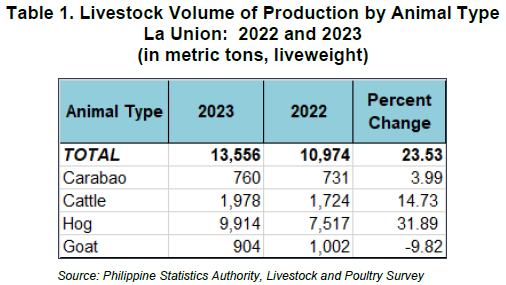
CARABAO
Total population of carabao in La Union as of 01 January 2024 was 43,801 heads. It decreased by 7.61 percent from previous year’s inventory of 47,407 heads. (Figure 1)
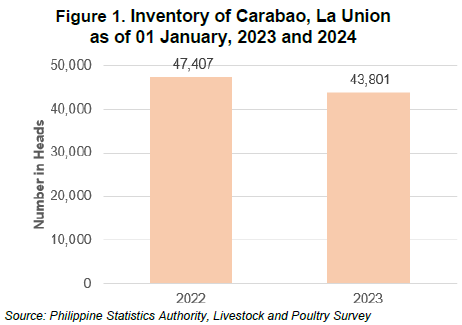
The total number of carabao butchered in slaughterhouses in 2023 increased by 7.57 percent over the 2022 level. A 4.88 percent decrease in the number of slaughtered carabao in slaughterhouses was recorded in 1st semester 2023 while a 21.79 percent increase was recorded in 2nd semester 2023.

CATTLE
The total cattle production in La Union in 2023 was recorded at 1,978 metric tons, liveweight. This was 14.73 percent higher than the 2022 output of 1,724 metric tons, liveweight. (Figure 2)
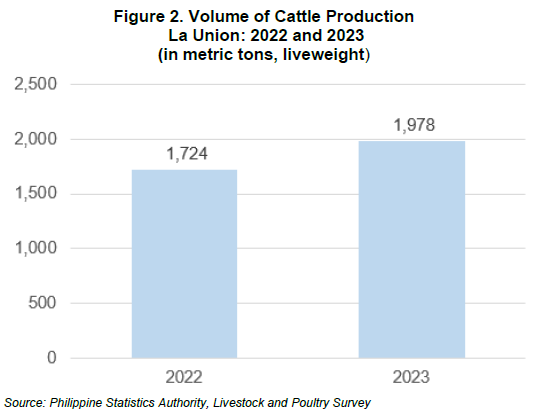
The total inventory of cattle as of 01 January 2024 was 45,749 heads. This recorded an increase of 1.77 percent from previous year’s inventory of 44,952 heads. (Figure 3)
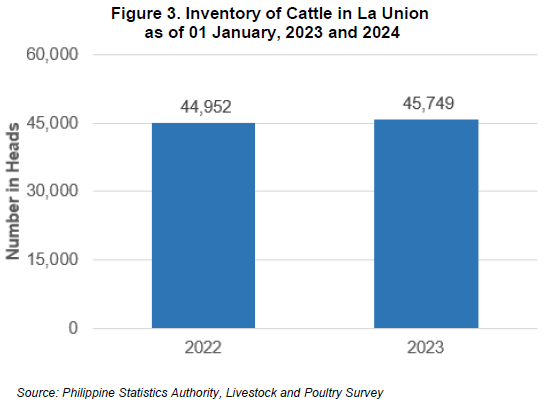
There were 6,784 heads of cattle slaughtered in the province’s slaughterhouses in 2023. This registered an increase of 7.82 percent over the 2022 level of 6,292 heads. The number of cattle butchered both in the 1st and 2nd semesters of 2023 increased by 7.26 percent and 8.40 percent, respectively. (Table 3)
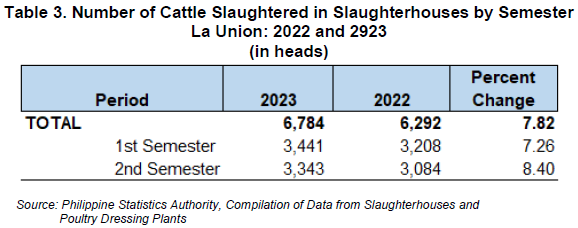
HOG
The total volume of hog production in 2023 was 9,914 metric tons, liveweight. This was 31.89 percent higher compared with the previous year’s level of 7,517 metric tons liveweight. (Figure 4)
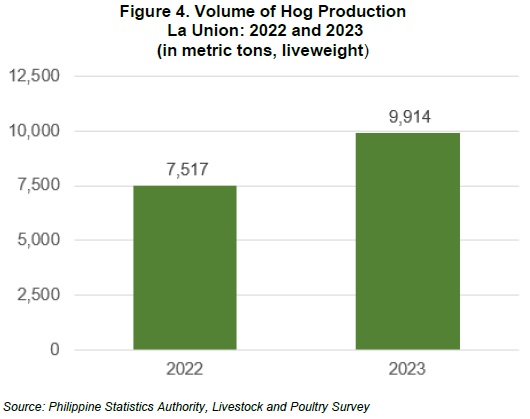
As of 01 January 2024, the total inventory of swine in the province was estimated at 68,976 heads. This represents a decrease of 7.74 percent compared with the previous year’s stocks of 74,760 heads. (Figure 5)

The total number of hogs slaughtered in the La Union’s slaughterhouses in 2023 was recorded at 128,329 heads. This recorded an increase of 18.15 percent over 2022 level of 108,619 heads. Increase in the number of hogs slaughtered of about 16.44 percent in the 1st semester 2023 was noted compared with the same period of 2022. Moreover, the number of heads slaughtered during the 2nd Semester 2023 increased by 19.79 percent over the 2nd semester 2022 level. (Table 4)
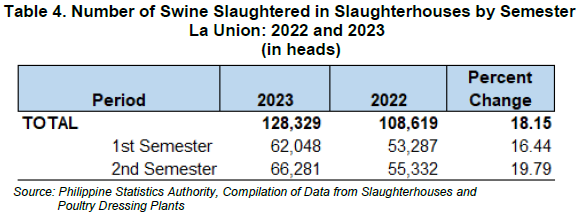
The average monthly farmgate prices of hog for slaughter in backyard farms in 2023 were generally lower than the 2022 price level. The highest farmgate price of hog for slaughter in backyard farms in 2023 was recorded in April at PhP202.91 per kilogram liveweight while the lowest price was recorded in January at PhP 125.00 per kilogram liveweight. (Figure 6)
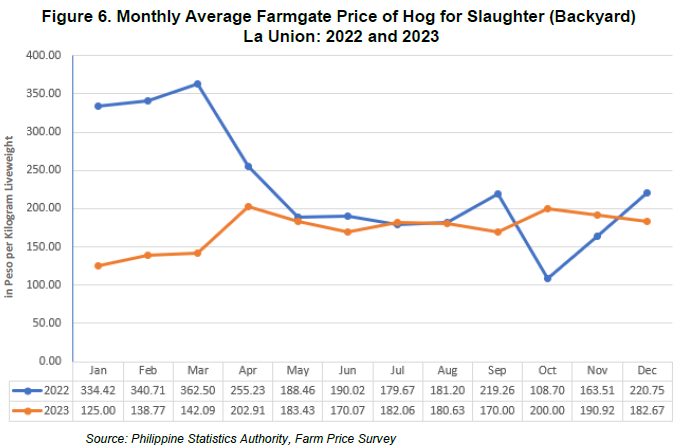
GOAT
The total volume of goat production in 2023 was 904 metric tons, liveweight. This was lower by 9.78 percent from the 2022 recorded output of 1,002 thousand metric tons, liveweight. (Figure 7)
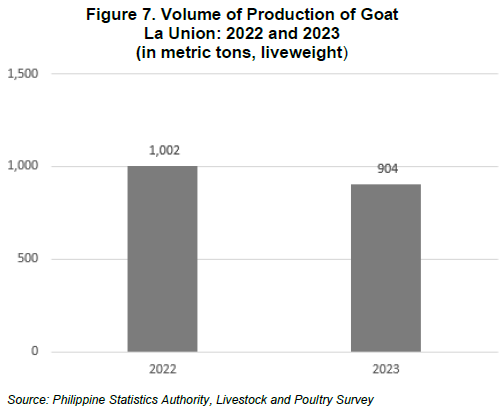
As of 01 January 2024, the total inventory of goat was estimated at 100,214 heads. This was 2.21 percent lower than its previous year’s level of 102,476 heads. (Figure 8)
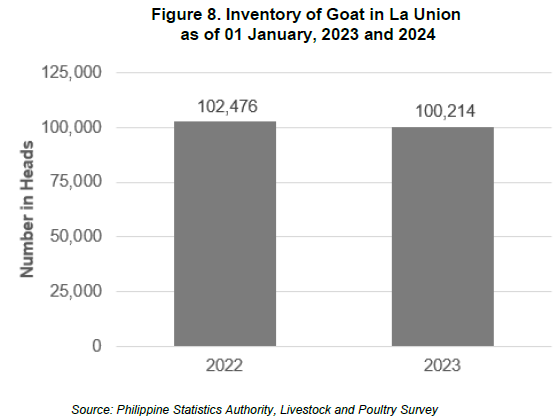
Around 1,251 heads of goat were slaughtered in the slaughterhouses in 2023. This was higher by 3.82 percent compared with last year’s level of 1,205 heads. Increases in the number of heads in both 1st and 2nd semesters of about 6.41 percent and 1.31 percent, respectively were recorded.
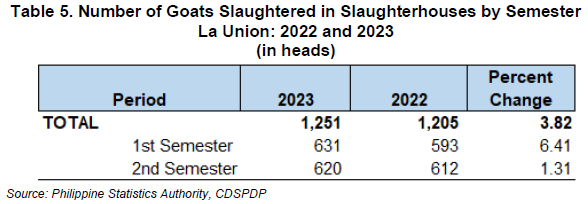
The average monthly farmgate prices of goat for slaughter in backyard farms from January to July 2023 were higher than the 2022 price level. The average monthly farmgate price dropped to PhP232.27 per kilogram liveweight in August, the lowest price recorded in 2023. However, the average monthly farmgate price of goat for slaughter in backyard farms went up in September aat PhP300.00 per kilogram liveweight. The average monthly farmgate prices were also higher in November 2023 at PhP274.07 and in December 2023 at PhP300.00 compared with the average monthly farmgate prices in the same months of the previous year. Meanwhile, the average monthly farmgate price of goat for slaughter in October 2023 at PhP260.00 was lower than the October 2022 price of PhP364.91. (Figure 9)
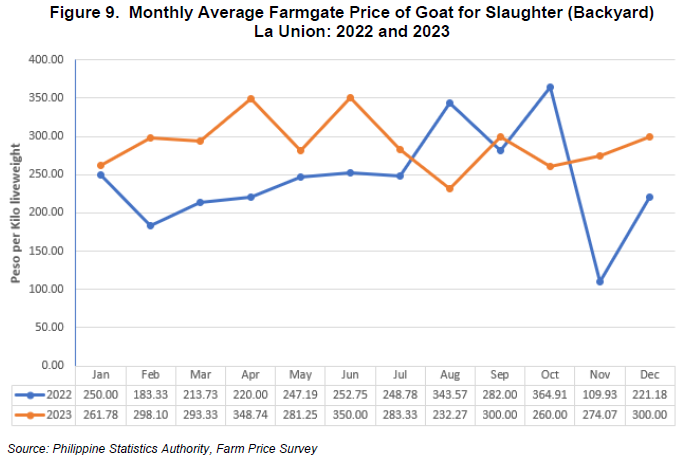
TECHNICAL NOTES
The data for this report is collected by the PSA through two (2) major surveys, namely the Backyard Livestock and Poultry Survey (BLPS) and the Commercial Livestock and Poultry Survey (CLPS).
Another survey that supplements the data requirements of the sub-sector is the Compilation of Data from Slaughterhouses and Poultry Dressing Plants (CDSPDP). This covers the Accredited (AAA, AA) and Locally Registered Meat Establishments (LRMEs) and is undertaken in coordination with the National Meat Inspection Service (NMIS) and the Provincial Veterinary Office (PVO).
Concepts and Definitions
Production. Refers to the volume of indigenous (locally-raised) animals disposed for slaughter which include animals exported or shipped-out for slaughter (in “head” and in “liveweight equivalent”).
Animal Inventory (also, Animal Population) – the number of domesticated animals in head present in the farm at specific reference date.
Abattoir (also, Slaughterhouse) –the premises that are approved, registered and licensed by the NMIS and Local Government Units (LGUs) in which food animals are slaughtered, dressed, inspected and hygienically handled in order to produce meat and offal that are safe and wholesome
Backyard Farm/Raiser- refers to any farm or household raising at least one head of animal or bird and does not qualify as a commercial farm.
Commercial Livestock Farm/Operator - refers to any livestock operator or farm which operation satisfies at least one of the following conditions: a) at least 21 head of adults and zero young, b) at least 41 head of young animals, and c) at least 10 head of adults and 22 head of young animals.
Commercial Poultry Farm/Operator - refers to any poultry operator or farm which operation satisfies at least one of the following conditions: a) 500 layers or 1,000 broilers; b) 100 layers and 100 broilers if raised in combination; and c) 100 head of duck regardless of age.
Farmgate Price - refers to the price received by livestock raisers for their produce at the location of farm. Thus, marketing costs such as transport and other marketing cost (if any) incurred in selling the produce are not included in the farmgate prices
Slaughter - butchering of animals for human consumption and other uses
SGD. DANITES E. TEÑIDO, PhD
Chief Statistical Specialist
/MAQ/AAA/KJGH

